Have you ever had items confiscated by the TSA? Ever wondered what items are TSA approved for carry-on bags? Are you confused as to what is and isn’t allowed in your carryon bag? If you answered yes to any of these questions you are not alone. It seems that every time you travel the TSA approved list has undergone some drastic changes. Keep on reading to find out more about TSA approved everyday essentials you can pack in your carry on.
Preparing to Pack Your Carry-On
Many people consider traveling quite stressful, but it doesn’t have to be if you plan ahead. Before you start packing your carry-on you want to do some basic research to find out what is and isn’t allowed in a carry-on.
Knowing ahead of time what items must be checked and what can be carried on before you arrive at the airport can save you a lot of time. Properly packing your carry-on speeds up the screening process, plus reduces the risk of you sounding an alarm.
When packing your carry-on keep in mind that if your bag or items inside the bag trigger an alarm you and your bag will be subjected to additional screening. Even if the items are usually permitted in carry-on bags there is no guarantee that they will always be allowed. Items that trigger alarms, pose a security concern, or look like they have been tampered with may be confiscated from you during the screening process.
Whether or not an item is allowed through the checkpoint is up to the individual TSA agent.
What Can I bring in my Carry-On?
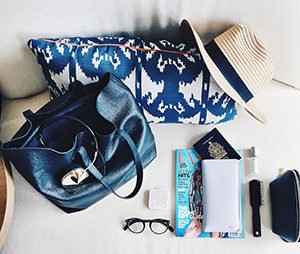
We have all heard stories about items being confiscated by the TSA. To prevent that from happening to you know what you can and can’t bring with you in a carry-on. Most everyday items can be packed in your carry-on, such as clothes, hairbrushes, toothbrushes, medications, and many other everyday items.
Items allowed in your carry-on that might surprise you include non-rechargeable batteries, rechargeable batteries, including spares, e-cigarettes and vaping devices, hand tools less than 7 inches without sharp edges, safety matches, and scissors that are less than 4 inches.
When it comes to toiletries there is the 3-1-1 rule you need to follow. All liquids, gels, and lotions must be in a container that is 3.4 ounces or less. All the items need to fit inside a 1-quart clear Ziploc bag. Each passenger is allowed a single bag.
With the 3-1-1, rule there are some exceptions, which include baby formula, breast milk, duty-free items purchased after going through security, and medical items. If you are not sure about whether an item is allowed or not you can contact TSA either on Facebook messenger or Twitter with a picture of the item.
Can a Flashlight be Considered a Weapon?
Weapons are one of those items on the restricted list. They must be checked and sometimes declared at check-in. What about flashlights though? As you all know some flashlights can be used for self-defense, so wouldn’t that make them a weapon? Striking bezels are the perfect example of how a flashlight can be used as a weapon.
Although some flashlights can be used as a weapon not all of them have to be checked. If the flashlight is longer than 7 inches when fully assembled they must be checked. If they are less than 7 inches when measured from end to end they are allowed in your carry-on.
Can I Bring Batteries in my Carry-on?
For various reasons, you will always find yourself traveling with batteries. Not all batteries are allowed in carry-on bags, some must be checked, and some are banned. Knowing the difference will save you from the hassle of having to replace your batteries upon arrival to your destination.
Batteries allowed in carryon bags are dry cell alkaline, dry cell rechargeable, lithium ion, lithium metal, and non-spillable wet batteries. Lithium batteries must be consumer sized (100-watt hours per battery).
Up to 2 spare lithium batteries can be carried on. Nonspillable wet batteries are limited to 12 volts and 100-watt hours and must be the absorbed electrolyte type. Spare lithium batteries are not allowed in your checked luggage, but all other batteries are.
Can Restricted Items be Checked?
Restricted items, or items that you cannot bring into the cabin with you, have the ability to be checked as long as they are not on the banned list. Here is a closer look at items that must be checked rather than carried on:
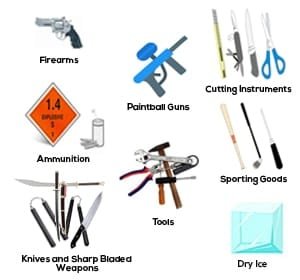
Firearms: They must be unloaded and placed in a locked hard-side container. Firearms must be declared at check-in. Firearm Replicas and firearm parts must also be checked. Federal laws apply to aircraft and secured areas of airports, local or state concealed carry laws do not apply. Attempting to enter secured areas with a concealed or open carried weapon can lead to you being arrested.
Ammunition: Must be packed in fiber, wood, or metal boxes and has to be declared at check-in.
Paintball Guns: Any compressed air gun can be checked, but the compressed air cylinder cannot be attached. Compressed gas cylinders are banned.
Cutting Instruments: Box cutter, carpet knives, straight razors, metal scissors with pointed tips, and anything with a folding or retractable blade must be checked.
Knives and Sharp Bladed Weapons: Swords, machetes, martial art weapons, etc must be checked. Round bladed butter knives or plastic knives are the only exceptions in this case.
Sporting Goods: Bats, hockey sticks, golf clubs, pool cues, bows and arrows, ski poles, lacrosse sticks, and any other sporting goods.
Tools: If they are longer than 7 inches they must be checked. All power tools need to be checked, as well as any tool with a sharp or cutting edge.
Dry Ice: Can be used for packing perishables. 5.5 pounds is allowed to be carried on board as long as the package is properly vented.
What Items Are Not Allowed at All?
Some items are prohibited from all airlines, meaning they cannot be checked or carried on. If you are going to need these items at your destination your best options are to mail them ahead of time or purchase them after you have arrived. Here is a closer look at items that are banned from air travel:
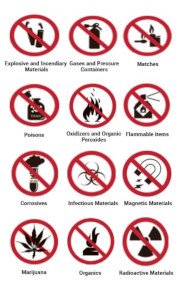
Explosive and Incendiary Materials: Gasoline, grenades, plastic explosives, gunpowder, fireworks, flares, blasting caps, dynamite, and anything that can be considered a replica of these items
Gases and Pressure Containers: Aerosols, carbon dioxide cartridges, oxygen tanks both scuba and medical, tear gas, mace, self-inflating rafts, deeply refrigerated gases, and pepper spray
Matches: Strike anywhere matches
Poisons: Weed killers, rodent poisons, cyanides, arsenic, pesticides, insecticides
Oxidizers and Organic Peroxides: Fertilizers, swimming pool or spa chemicals, fiberglass repair kits, bleach, nitric acid
Flammable items: Gas, torches, flammable liquid fuel, paint thinner, flammable paints, cooking fuel
Corrosives: Car batteries, wet cell batteries, lye, acids, mercury. Alkalis, drain cleaners
Infectious Materials: Viral organisms, bacterial cultures, medical laboratory specimens
Magnetic Materials: Strong magnets like the ones found in lab equipment
Marijuana: No matter the form it is not allowed on airplanes or in the secured part of airports
Organics: Peroxides, fiberglass resins
Radioactive Materials: Some exceptions will be made for implanted radioactive medical devices, but everything else is banned
Essential Everyday Carry-On Items for Travel
Passport
You never know when you are going to need your passport when traveling. Not only should you carry your passport, but you should also make a photocopy of it, as well as a scanned copy.
Identification
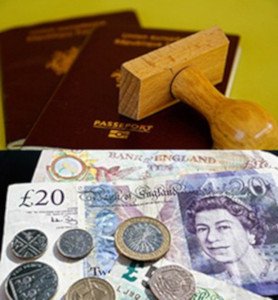
Your passport can be used for identification, but you should always carry a state issued ID. If you have a driver’s license it should be carried along with proof of your car insurance. Keep the 24-hour insurance claim number with you.
Health-Related Items
Always carry your health insurance card. If you have any health conditions carry information detailing your conditions, along with a list of medications you are currently taking. Bring enough medication to cover an extra three days in case of an emergency while traveling.
Currency
Carry a variety of currency just in case the unexpected happens. Keep credit cards in separate locations in case of theft. Bring traveler’s checks or personal checks along with some cash. Never keep all of your currency in one location in case of theft.
Emergency Contacts
Carry on your person a list of emergency contacts, including phone numbers and email addresses.
Emergency Kit
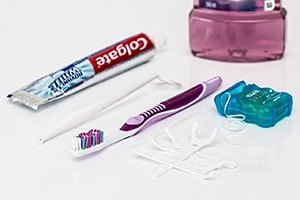
This will contain basic first aid items. Band-aids, instant hot/cold packs, medications, bug spray, sunscreen, antibiotic ointment, and anything else you would use when rendering basic first aid. Just when packing the kit if any lotions, gels, or liquids are included they must comply with the 3-1-1 rule.
Baby Wipes/Sanitizer
Hand sanitizer must follow the 3-1-1 rule. Wipes do not have to follow the rule so it might be helpful to pack whatever you can in wipe form. Baby wipes are great for cleaning yourself up, while sanitizer wipes can quickly clean anything questionable.
Snacks
You never know what can happen when traveling, so having snacks on hand can be helpful. Certain foods, such as creamy dips, require you to follow the 3-1-1 rule. Other foods can be packed freely, but protein bars and granola bars are great for traveling.
Water Bottle
You want to stay hydrated, but buying bottled water is expensive. Make sure the bottle is empty when going through security and fill up at a water fountain on your way to the gate.
Flashlight
You never know when you will need light, so keep your LED light handy. Lights that are less than 7 inches from end to end can be packed in your carry-on. If you don’t have one that is less than 7 inches now is the time to buy a new one.
Batteries/Chargers
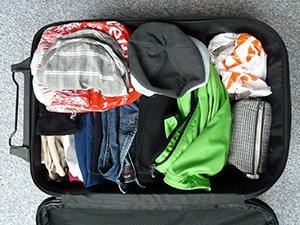
If your light is rechargeable bring your charging cord. If your light requires battery bring along a couple of spare sets. Spare lithium batteries cannot be checked, they can only be carried on. Cell phone chargers and/or spare USB cables that are used for charging cell phones and other electronics should also be packed.
Travel Pillow
You never know when you need some extra cushion. Long flights tend to be uncomfortable as you sit upright for periods of time. Travel pillows make napping on the go possible.
Change of Clothes
You never know when you are going to get separated from your luggage. Having a change of clothes or even two changes of clothes with you in your carryon allows you to plan for the unexpected.
TSA Approved Everyday Essentials Final Thoughts
Traveling is stressful enough without having to worry about passing through security. Properly packing your bags saves you time as it takes the hassle out of the screening process. Properly packed bags have a lower risk of triggering alarms allowing you to pass through security in plenty of time for your flight. Properly packing your bag requires you to know what items can be carried on, what ones need to be checked, and what is banned.
Now you can put this knowledge to work the next time you travel with your carry-on. Thank you for visiting BestTacticalFlashlights.net. Please take a look at our flashlight reviews or our flashlight buyers guides for all your flashlight needs.
